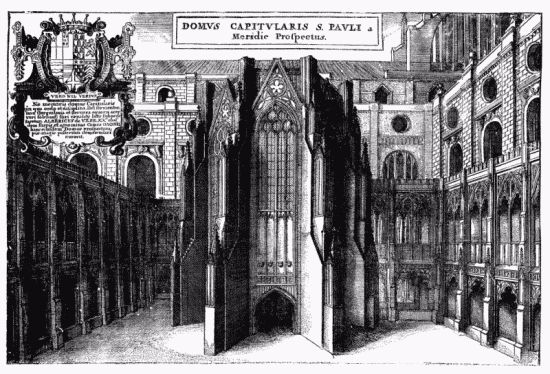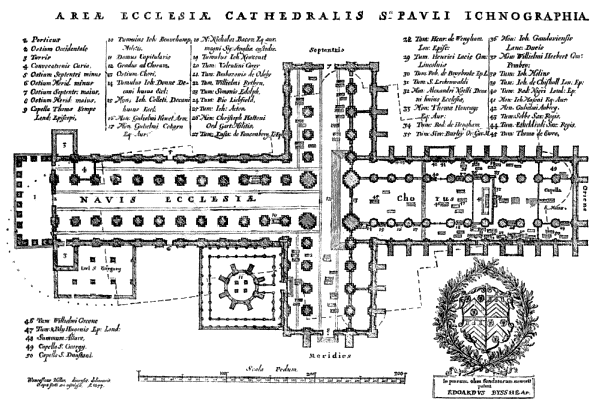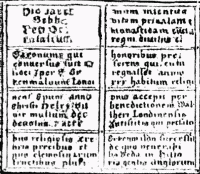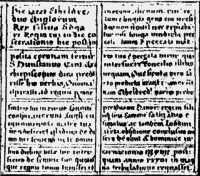St Pauls, Index
CHAPTER III.
THE INTERIOR OF OLD ST. PAUL'S.
Fine coup d'œil on entering the Nave—"Paul's Walk"—Monuments in Nave—Sir John Montacute—Bishop Kempe—Sir John Beauchamp, wrongly called afterwards Duke Humphrey's—The Choir—Shrine of St. Erkenwald—Nowell—Braybrooke—two Kings—many Bishops—Elizabethan Worthies.
The aspect of the Nave, on entering the western door, must have been magnificent. There were twelve bays to the nave, then the four mighty pillars supporting the tower, then the screen closing in the choir. The nave was known as "Paul's Walk," and not too favourably known, either, under this title. Of this more hereafter. At the second bay in the North Aisle was the meeting-place of Convocation, closed in as a chamber. Here, too, was the Font, by which was the Monument of Sir John Montacute. He was the son of the first Earl of Salisbury, and it was his mother of whom the fictitious story about the establishment of the Order of the Garter by Edward III. was told. John de Montacute's father was buried in the Church of the Whitefriars. The son was baptized in St. Paul's, and directed in his will, "If I die in London I desire that my body may be buried in St. Paul's, near to the font wherein I was baptized."
At the sixth bay came "the Little North Door," and it was answerable, as till lately was a similar door at St. Alban's Abbey, for much of the desecration of the church which went on. There was a notice on it that anybody bringing in burden or basket must pay a penny into the box at hand. Between the columns of the tenth bay was the Chantry of Bishop Kempe (1450-1489). It was the finest in the cathedral, built by Royal licence. He did much for the beautifying of the cathedral, and rebuilt Paul's Cross, as we have said already. He seems to have kept clear of the fierce struggles of the Wars of the Roses, for he saw rival kings in succession[page 14] ostentatiously worshipping in St. Paul's, and did not lose the friendship of any of them. So far as one can judge, he honestly felt that he was not called upon to become a partisan of any, and this fact was recognised.
It was Edward IV. who gave him licence to erect his chantry. "For the singular reverence which he bore to God and to the blessed and glorious Virgin Mary, as also to the holy Apostles Peter and Paul, and to St. Erkenwald and Ethelbert, those devout confessors, he granted license to Thomas Kempe, Bishop of London, for the founding of a chantry of one priest, who should be the Bishop of London's confessor in this cathedral, for the time being, to celebrate divine service daily at the altar of the Holy Trinity in the body thereof, towards the north side, for the good estate of the said King and Queen Elizabeth, his Consort; as also of the said Bishop, during their lives in this world, and for the health of their souls after their departures hence, and moreover for the souls of the said King's progenitors; the parents and benefactors of the said bishop and all the faithful deceased; and to unite it to the office of confessor in this church for ever, and likewise to grant thereunto one messuage, one dovehouse, 140 acres of land, six acres of meadow, with eight acres of wood, called Grays, and 10s. rent with the appurtenances, lying in Great Clacton in the county of Essex; as also another messuage, twenty acres of land, two acres of meadow and two acres of wood, with the appurtenances in the same town, and two acres of land lying in Chigwell, together with the advowson of the Church of Chigwell, in the same county."
The next monument has a very strange and quaint interest. It was nearly opposite Kempe's, in the eleventh bay on the south side, that of Sir John Beauchamp, of Powick, in Worcestershire (son of Guy, Earl of Warwick), who died in 1374. He settled, out of some tenements in Aldermanbury, for the payment of 10 marks a year for a priest to celebrate at his altar, and 50s. a year for the special keeping of the anniversary of his death, December 3rd. There was a very fine image of the B.V.M. beside this tomb. Barnet, Bishop of Bath and Wells, gave a water mill, ninety acres of arable and pasture, and eight acres of wood, all lying at Navestock, in Essex,[page 15] to the Dean and Chapter for the saying of certain prayers and a de profundis beside this image for the souls of the faithful; and there were constant oblations here. John Westyard, citizen and vintner, founded another altar at the same place for a chantry priest to say masses for the soul of Thomas Stowe, sometime Dean of St. Paul's, and for those of his parents and benefactors. In after years a strange mistake befell this tomb, one wonders why. It became popularly known as the tomb of Duke Humphrey, of whom we have more to say hereafter, who was buried not here but at St. Albans.
Entering within the choir, the first monument—a marble altar tomb—was that of Thomas Ewer, or Evere, who was Dean for twelve years, and died in 1400. In a straight line with it, before the steps of the high altar, lay Robert Fitzhugh, Bishop 1431-1436, who, as the learned Chancellor of the University of Cambridge, was sent as an English delegate to the Council of Basel. Whilst he was there he was elected to the See of London, and consecrated at Foligno. He was an earnest labourer for the betterment of the poor clergy in his diocese. Immediately behind the high altar screen was the magnificent shrine of St. Erkenwald, and beside it the tomb of Dean Nowell, both of which are described hereafter (see pp. 24, 51). East of this again, at the entrance to the Lady Chapel, was the beautiful brass of Robert Braybrooke, Bishop 1381-1405. His was a troublous time, the time of the evil government of Richard II. The Bishop exerted himself with all his might to bring about righteous government, and to draw the king away from evil counsellors. But he also persuaded the citizens to keep the peace when they would have run into riot, and was all his life held in honour. He was fierce against the Lollards, hardly to be wondered at, as they were constantly affixing papers against current doctrines and doings on the doors of the cathedral. It was this bishop who rebuked the citizens for their neglect of the Feast of the Conversion of St. Paul, their patron saint, and he made arrangements for special services, which from that time were carefully observed. He also gave directions for more devout observance of St. Erkenwald's Day, and set aside money from the See for the feeding of 15,000 poor people on that day in St. Paul's Churchyard. Robert Preston, a grocer, left a rich sapphire to the shrine, to be used for rubbing the eyes of persons[page 16] who were threatened with blindness, and Braybrooke gave orders that the clergy should appear on all these high festivals in their copes, that nothing might be lacking to do them honour. He offered no opposition to the deposition of King Richard II.: it was clearly inevitable. Braybrooke was a vigorous reformer of abuses, and denounced the profanation of the church by traffickers, shooting at birds inside, and playing at ball.
Alongside the Lady Chapel, on the north side, was the chapel of St. George. We will now pass from it back by the north aisle. By the pillar north of the altar screen was the tomb of Sir Thomas Heneage. He was Vice-Chamberlain to Queen Elizabeth, and all his life was much trusted by her in matters of foreign diplomacy, though he sometimes got into trouble by taking too much on himself. His daughter Elizabeth was ancestress of the Earls of Winchelsea. He died in 1595.
Opposite this, at the North Wall, was the tomb of Ralph Hengham (d. 1311). Like so many great lawyers of old time he was in Holy Orders, Chancellor of the Diocese of Exeter, and also Chief Justice of the King's Bench. He was sent to the Tower for falsifying a document, which he is said to have done in order to reduce a fine imposed on a poor man from 13s. 4d. to 6s. 8d., and was himself fined heavily; the money being applied to building a clock tower in Palace Yard, opposite the door of Westminster Hall. Two judges, on being urged to tamper with records for beneficent purposes, are said to have declared that they did not mean to build clock towers! He was afterwards restored to office. He did good work in his day in compiling a Digest of the law.
SIR SIMON BURLEY, K.G., tutor and adviser of Richard II., beheaded on the charge of having corrupted the King's Court, 1388.
[plate 9]
THE
CHAPTER
HOUSE AND
CLOISTER.
After W. Hollar.
[plate 9a]

THE
CHAPTER
HOUSE AND
CLOISTER-Detail of Arms and Inscription.
After W. Hollar.
[plate 10]
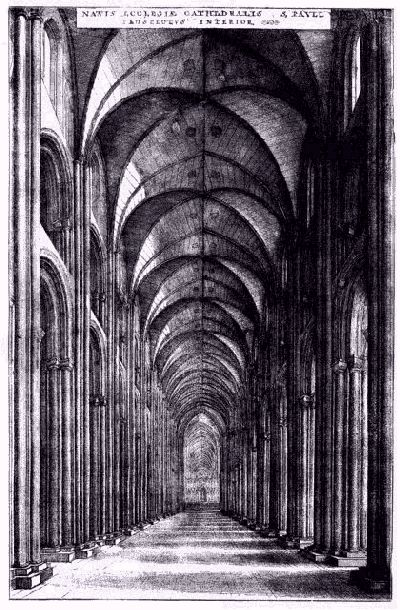
THE
NAVE, OR
PAUL'S
WALK.
After W. Hollar.
[plate 11]
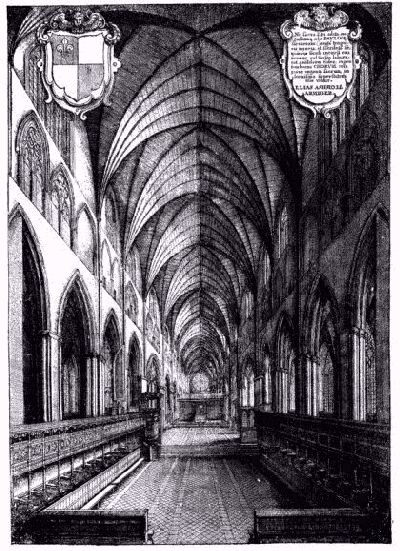
THE
CHOIR.
After W. Hollar.
[plate 11a]
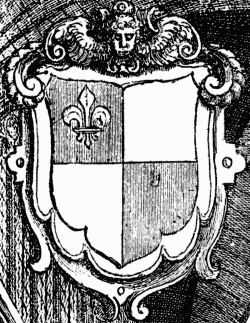
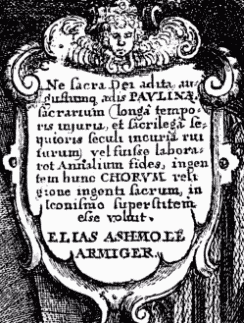
THE
CHOIR.
Detail of Arms and Inscription.
After W. Hollar.
[plate 12]
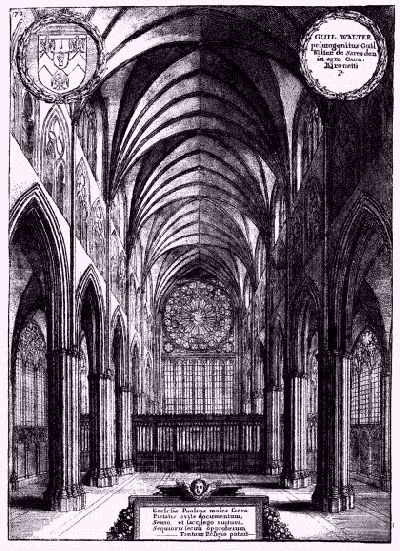
THE
LADY
CHAPEL.
After W. Hollar.
[plate 13]
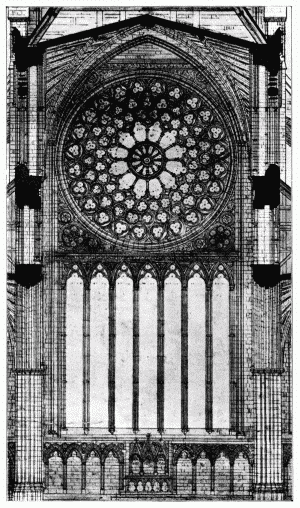
THE
ROSE
WINDOW.
From a Drawing by E.B. Ferrey in the Trophy Room, St. Paul's Cathedral.
[plate 14]
GROUND
PLAN OF
OLD
ST.
PAUL'S.
After W. Hollar. The dotted line shews the position of Wren's Cathedral.]
[plate 15]
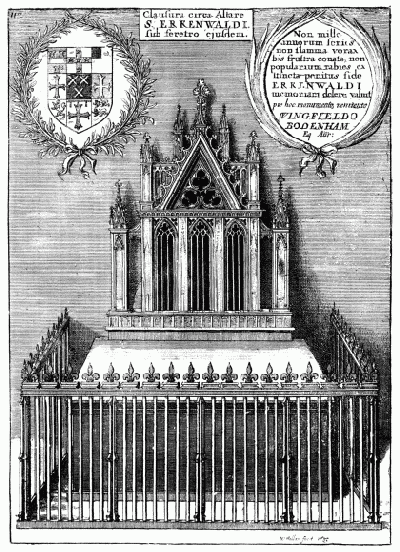
THE
SHRINE OF
ST.
ERKENWALD.
After W. Hollar.
[plate 16]
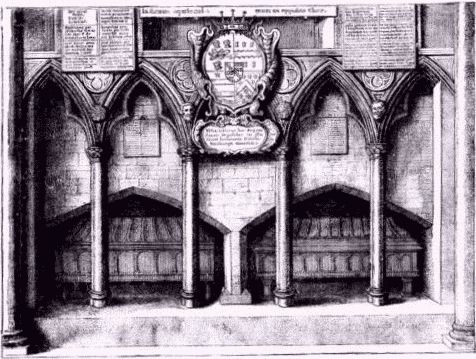
THE
TOMBS OF
SEBBA AND
ETHELRED.
After W. Hollar.
[plate 16a]
THE
TOMBS OF
SEBBA AND
ETHELRED.
Inscriptions - Click to Enlarge
After W. Hollar.
St. Paul's, as we see, was rich in tombs of mediæval bishops; as to Royalty it could not be named as compared with Westminster Abbey, for the City was not a royal residence except in very rare cases. But here we come to two tombs of Kings. Sebba was buried in the North Aisle in 695. He had been King of the East Saxons, but being afflicted with grievous sickness he became a monk. His tomb remained until the Great Fire, as did that of Ethelred the Unready, next to it. On the arches above were tablets containing the following inscriptions:—
"Hic jacet Sebba Rex Orientalium Saxonum; qui conversus fuit ad fidem per Erkenwaldum Londonensem Episcopum, anno Christi[page 17] DCLXXVII. Vir multum Deo devotus, actibus religiosis, crebris precibus & piis elemosynarum fructibus plurimum intentus; vitam privatam & Monasticam cunctis Regni divitiis & honoribus præferens: Qui cum regnasset annos XXX. habitum religiosum accepit per benedictionem Waltheri Londinensis Antistitis, qui præfato Erkenwaldo successit. De quo Venerabilis Beda in historia gentis Anglorum."1
"Hic jacet Ethelredus Anglorum Rex, filius Edgari Regis; cui in die consecrationis his, post impositam Coronam, fertur S. Dunstanus Archiepiscopus dira prædixisse his verbis: Quoniam aspirasti ad regnum per mortem fratris tui, in cujus sanguinem conspiraverunt Angli, cum ignominiosa matre tua; non deficiet gladius de domo tua, sæviens in te omnibus diebus vitæ tuæ; interficiens de semine tuo quousque Regnum tuum transferatur in Regnum alienum, cujus ritum et linguam Gens cui præsides non novit; nec expiabitur nisi longa vindicta peccatum tuum, & peccatum matris tuæ, & peccatum virorum qui interfuere consilio illius nequam: Quæ sicut a viro sancto prædicta evenerunt; nam Ethelredus variis præliis per Suanum Danorum Regem filiumque suum Canutum fatigatus et fugatus, ac tandem Londoni arcta obsidione conclusus, misere diem obiit Anno Dominicæ Incarnationis MXVII. postquam annis XXXVI. in magna tribulatione regnasset."2
Certainly in this latter terrible epitaph, it cannot be said that the[page 18] maxim de mortuis was observed. But it speaks the truth.
Of a much later date is a royal monument, not indeed of a king, but of the son and father of kings, namely, John of Gaunt. He died in 1399, and his tomb in St. Paul's was as magnificent as those of his father in the Confessor's Chapel at Westminster, and of his son at Canterbury. It was indeed a Chantry founded by Henry IV. to the memory of his father and mother, Gaunt and Blanche of Lancaster. She was Gaunt's first wife (d. 1369), and bore him not only Henry IV., but Philippa, who became wife of the King of Portugal, and Elizabeth, wife of John Holland, Earl of Huntingdon. It was through Blanche that Gaunt got his dukedom of Lancaster. She died of plague in 1369, during his absence in the French Wars, and was buried here. Before his return to England he had married (in 1371) Constance, daughter of Pedro the Cruel, and hereby laid claim to the crown of Castile, as the inscription on his monument recorded. Their daughter married Henry, Prince of the Asturias, afterwards King of Castile. Constance died in 1394, and was also buried in St. Paul's, though her effigy was not on the tomb. In January, 1396, he married Catharine Swynford, who had already borne him children, afterwards legitimised. One of them was the great Cardinal Beaufort; another, John Beaufort, Earl of Somerset, was the grandfather of Margaret Tudor, mother of Henry VII. Gaunt's third wife (d. 1403) is buried at Lincoln. The long inscription on the monument closed with the words, "Illustrissimus hic princeps Johannes cognomento Plantagenet, Rex Castilliæ et Legionis, Dux Lancastriæ, Comes Richmondiæ, Leicestriæ, Lincolniæ et Derbiæ, locum tenens Aquitaniæ, magnus Seneschallus Angliæ, obiit anno XXII. regni regis Ricardi secundi, annoque Domini MCCCXCIX."
Close by John of Gaunt, between the pillars of the 6th bay of the Choir, was the tomb of WILLIAM HERBERT (1501-1569), first Earl of Pembroke of the second creation, a harum-scarum youth, who settled down into a clever politician, and was high in favour with Henry VIII., who made him an executor of his will, and nominated him one of the Council of twelve for Edward VI. He went through the reign of Mary not without suspicion of disloyalty, but was allowed to hold his place at Court, and in the reign of Queen Elizabeth he[page 19] was accused of favouring the Queen of Scots, though here also he overcame the suspicions, and did not lose his place. He married Anne, the sister of Queen Catherine Parr, and they were both buried in St. Paul's.
JOHN OF CHISHULL, who filled the see from 1274-1280, and was Edward III.'s Chancellor, held a great number of valuable posts together. This may have produced the mental incapacity into which he fell. Archbishop Peckham had to appoint a commission to manage the diocese. He was buried against the wall of the North Aisle, not far from John of Gaunt.
ROGER NIGER, bishop from 1228 to 1241, was buried under the fifth bay of the Choir, between it and the North Aisle. There were three inscriptions on his tomb, the first on the aisle side:
"Ecclesiæ quondam Præsul præsentis, in anno
M bis C quater X jacet hic Rogerus humatus:
Hujus erat manibus Domino locus iste dicatus:
Christe, suis precibus veniam des; tolle reatus."
Then we have a short biography in laudatory terms, and below that a record which one may translate as it stands: "It came to pass while this Bishop Roger stood mitred [infulatus] before the high altar, ready to begin the Divine mysteries, there came on such a dense cloud that men could scarcely discern one another; and presently a fearful clap of thunder followed, and such a blaze of lightning and intolerable smell, that all who stood by fled hastily, expecting nothing less than death. The Bishop and one deacon only bravely remained, and when the air was at length purified the Bishop completed the service." We shall have more about this storm hereafter.
SIR JOHN MASON (1503-1566), the son of a cowherd at Abingdon, and afterwards a great benefactor to that town. His mother was a sister to the Abbot of Abingdon, and through this relationship he was educated at Oxford, became a Fellow of All Souls', took orders, and, in consequence of the skill which he displayed in diplomacy and international law, received rich Church preferments, among them the Deanery of Winchester. At the accession of Queen Mary he had to relinquish this, but as he had been faithful to her, she showed him much favour, and gave him some secular offices.[page 20] On the accession of Elizabeth, he returned to his Deanery, and was all his life one of the most trusted of the Queen's councillors, especially in foreign matters.
DR. WILLIAM AUBREY was appointed Vicar-General of Canterbury by Archbishop Grindal, and was esteemed a great lawyer in his time. He was the grandfather of the famous antiquary (d. 1595).
Crossing the Choir, and beginning from the west, we will now proceed eastward along the South Aisle of the Choir. First, we come to two famous Deans, Donne and Colet, the account of whom belongs to a subsequent page. In fact, the greater number of monuments in this aisle are of later date than the others, but it will be more convenient to take them here, excepting those which are connected with the subsequent history. The wall monument of WILLIAM HEWIT (arms, a fesse engrailed between three owls) had a recumbent figure of him in a layman's gown. He died in 1599.
SIR WILLIAM COKAYNE (d. 1626) was a very rich Lord Mayor; high in the confidence of James I., who constantly consulted him on business. He was a munificent contributor to good works. It was said of him that "his spreading boughs gave shelter to some of the goodliest families in England." From his daughters descended the Earls of Nottingham, Pomfret, Holderness, Mulgrave, and Dover; the Duke of Ancaster, and the Viscounts Fanshawe.
JOHN NEWCOURT, Dean of Auckland, Canon of St. Paul's, Doctor of Law (d. 1485).
The handsome brass of ROGER BRABAZON, Canon of St. Paul's (d. 1498), had a figure in a cope. At the foot was the scroll, "Nunc Christe, te petimus, miserere quæsumus: Qui venisti redimere perditos, noli damnare redemptos."
Passing into the south side of the Lady Chapel, we come to two more mediæval Bishops of London: HENRY WENGHAM (1259-1262). He was Chancellor to Henry III. Close to him was EUSTACE FAUCONBRIDGE, a Royal Justiciary, and afterwards High Treasurer, and Bishop of London, 1221-1228.
WILLIAM RYTHYN, LL.D., was Rector of St. Faith's and Minor Canon of the Cathedral (d. 1400).
RICHARD LYCHFIELD, Archdeacon both of Middlesex and of Bath,[page 21] Canon Residentiary of St. Paul's (d. 1496).
The tomb of SIR NICHOLAS BACON (1509-1579), Queen Elizabeth's famous minister, and father of the great philosopher, had his recumbent figure, and those of his two wives, Jane, daughter of William Fernley, and Ann, daughter of Sir Anthony Cooke. The latter was the mother of Francis. The Latin inscription on the tomb was most laudatory, and reads as if it came from the same pen that wrote the dedication of the Advancement of Learning.
Another of the Elizabethan worthies is SIR FRANCIS WALSINGHAM (d. April 6th, 1590). The monument to him was placed on the wall, with a long Latin biographical inscription and twenty lines of English verse.
Two other wall tablets in the same chapel commemorated other heroes of that period. SIR PHILIP SIDNEY, who died of his wound at Arnhem, October 15th, 1586, was buried in St. Paul's, with signs of public grief almost unparalleled. "It was accounted sin for months afterwards for any gentleman to appear in London streets in gay apparel." The tablet to him was of wood, and bore the following inscription:—
"England, Netherlands, the Heavens and the Arts,
The Soldiers, and the World, have made six parts
Of noble Sidney; for none will suppose
That a small heap of stones can Sidney enclose.
His body hath England, for she it bred,
Netherlands his blood, in her defence shed,
The Heavens have his soul, the Arts have his fame,
All soldiers the grief, the World his good name."
Close to this, on the same pillar, was a tablet to SIR THOMAS BASKERVILLE, who had also done good service as a brave soldier, according to the account given in fourteen lines of verse, which, it must be said, are a great deal more musical than Sidney's.
SIR CHRISTOPHER HATTON (1540-1591) had a finer monument than any of the other Elizabethan celebrities. Whether he deserved it is another matter. He was clever and handsome, and got into special favour with the Queen by his graceful dancing. He even wrote her amorous letters. The part he took in procuring the condemnation[page 22] of the Queen of Scots is well known.
At the extreme end of St. Dunstan's Chapel we come to another Mediæval worthy.
HENRY DE LACY, EARL OF LINCOLN (1249-1311), "the closest councillor of Edward I." (Bishop Stubbs), was somewhat doubtful in his loyalty to Edward II., being divided between his grateful memory of the father and his disgust at the conduct of the son. His house was on the site of Lincoln's Inn, which owes its name to him. He was a munificent contributor to the "new work" of St. Paul's, and was buried in St. Dunstan's Chapel, on the south side of the Lady Chapel.
[page 23]
And Last updated on: Thursday, 09-Jan-2025 14:15:35 GMT
